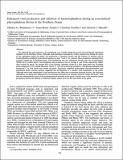Por favor, use este identificador para citar o enlazar a este item:
http://hdl.handle.net/10261/87320COMPARTIR / EXPORTAR:
 SHARE
BASE SHARE
BASE
|
|
| Visualizar otros formatos: MARC | Dublin Core | RDF | ORE | MODS | METS | DIDL | DATACITE | |

| Título: | Enhanced viral production and infection of bacterioplankton during an iron-induced phytoplankton bloom in the Southern Ocean |
Autor: | Weinbauer, Markus G.; Arrieta López de Uralde, Jesús M. CSIC ORCID ; Griebler, Christian; Herndl, Gerhard J. | Fecha de publicación: | 2009 | Editor: | American Society of Limnology and Oceanography | Citación: | Limnology and Oceanography 54(3): 774-784 (2009) | Resumen: | We followed the viral response to Fe-enrichment over 3 weeks during the second iron-enrichment experiment (EisenEx) in the Southern Ocean. Although viral abundance increased in a rather constant way during the course of the experiment inside the patch, the production of bacterial viruses and the fraction of infected cells in bacterioplankton exhibited pronounced maxima on days 7 and 21. In contrast, these parameters remained fairly constant outside the Fe-fertilized patch. Viral production was also stimulated directly after the Fe-enrichment. Within the Fe-replete patch, viral abundance and production was on average 2- and 3-fold, respectively, higher than outside the patch. On average 40% of the bacteria contained viruses in a lytic stage inside the Fe-replete patch compared to 21% outside the patch. About 11-12% of the bacteria contained a viral genome inducible with mitomycin C in both inside and outside the patch. Randomly amplified polymorphic desoxyribonucleic acid polymerase chain reaction analysis suggested the development of a specific viral community in the patch. Although short-term stimulation of viral production was likely due to increased bacterial activity, the long-term stimulation was likely also influenced by an increased encounter rate between bacterial viruses and hosts. Viral lysis was responsible for most of the bacterioplankton mortality in the patch. Overall, most of the bacterial carbon production entered the detrital or dissolved organic matter pool via the viral shunt in the patch. © 2009, by the American Society of Limnology and Oceanography, Inc. | Versión del editor: | http://aslo.org/lo/toc/vol_54/issue_3/0774.pdf | URI: | http://hdl.handle.net/10261/87320 | Identificadores: | issn: 0024-3590 |
| Aparece en las colecciones: | (IMEDEA) Artículos |
Ficheros en este ítem:
| Fichero | Descripción | Tamaño | Formato | |
|---|---|---|---|---|
| Weinbauer-Limnology-and-Oceanography-2009-v54-n3-p774.pdf | 633,88 kB | Adobe PDF |  Visualizar/Abrir |
CORE Recommender
Page view(s)
310
checked on 22-abr-2024
Download(s)
944
checked on 22-abr-2024
Google ScholarTM
Check
NOTA: Los ítems de Digital.CSIC están protegidos por copyright, con todos los derechos reservados, a menos que se indique lo contrario.
